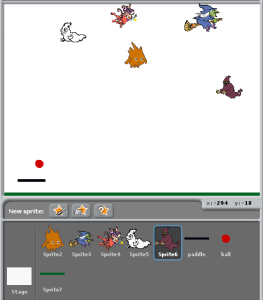 If you want to create a game in Scratch that has action and consequences, then you’re going to need to be able to determine where your sprites are and what they’re doing at any given time. To help us demonstrate how Scratch can sense information about the game in real time, we’ll draw inspiration from the classic arcade game Breakout.
If you want to create a game in Scratch that has action and consequences, then you’re going to need to be able to determine where your sprites are and what they’re doing at any given time. To help us demonstrate how Scratch can sense information about the game in real time, we’ll draw inspiration from the classic arcade game Breakout.
All posts by Michael Badger
Scratch 2.0 Book Sample Chapter

Packt has published Chapter 8, Chatting with a Fortune Teller as a sample chapter.
In the Breakout game we created in the previous chapters, we learned how easy it is to create projects that keep track of the changing values by using variables. However, variables have a limitation in they store only one value at a time. In this chapter, we’re going to create a random fortune-spewing teller,which will require the sprites to have access to a list of multiple values at one time.
Welcome to lists. In Scratch, a list feature allows us to associate one list with multiple items or values in almost the same way we create a list before going to the grocery store. We can think of the items in the list as variables. Each list item can be changed, removed, or added to.
Read the chapter here.
Scratch Day 2014 at Hoffman-Boston Elementary School
If you’re in the Arlington, VA area, join me at the Hoffman-Boston Elementary School for Scratch Day. Mike Lee and Jeff Elkner put on a great event.
| When: | May 17, 2014 – 10:00am 4 hours |
| Where: | Hoffman-Boston Elementary School 1415 S. Queen Street Arlington Virginia United States |